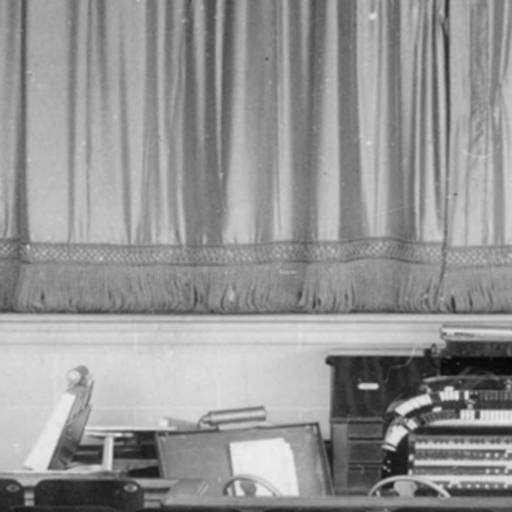
I'm just guessing the date. - Original organ console (Photograph from an archival source: unkown , submitted by Richard Allman /Richard Allman )
Note: Not extant. Not playable. (in this location)

2022-11-27 - From Cinema Treasures: One of the city’s most celebrated neighborhood theatres opened in October, 1926 to great fanfare. The premier was covered by a throng of reporters and was attended by some of Denver’s most notable names. Flowers piled high and telegrams arrived from Hollywood studio heads and movie stars. The public was held in awe at what they found inside: thick, luxurious carpets in jade green, wide, plush seats, an expansive auditorium ceiling painted sky blue with hundreds of tiny, twinkling lights that looked like stars when the house lights were turned down, a completely equipped nursery, a large waiting room and an exotic smoking lounge. They found Arabian murals and decorations, and even a bubbling fountain. Everything inside was worthy of Ali Baba himself, down to the drapes and furnishings, wrought iron and blown glass hanging lanterns and standing lamps. It was truly “The Arabian Nights Meets the Rockies”. The auditorium had a large orchestra pit and a 14 rank electric theatre organ. When movies weren’t being shown, the screen was lifted to expose the large stage, big enough to hold almost any entertainment venue. Opening night featured a short organ concert followed by a soprano solo of “Allah’s Garden of Roses”, which was written especially for the premiere. That was followed by “A Dream of India”, and several numbers played by Dahl’s Arabian Nights Orchestra. A stage show included a bevy of girls in blond wigs and black shorts and tops dancing the Black Bottom. The first movie shown at the Aladdin Theatre was “Across the Pacific”, starring Monte Blue and Myrna Loy. The Aladdin Theatre opened in the days of the silent movies, but management was quick to pick up on the latest technology: sound. Although a few theatres in Denver had experimented with the sound process, in February, 1927 the Aladdin Theatre had a showing of its first Vitaphone film, “Don Juan”, starring John Barrymore, grandfather of actress Drew Barrymore. The film featured synchronized music and a short lecture by Will Hays, Hollywood movie czar. Later that same year, the public was treated to a run of “The Jazz Singer”, with Al Jolson, which is generally recognized by movie historians as the film that ushered in the talkies. The Aladdin Theatre was built on a site formerly occupied by a mansion belonging to Ed Chase, an early theatre owner and well-known gambling kingpin. The Aladdin Theatre enjoyed a long, successful run as a first-run movie house. It survived after many of the big screen theatres downtown had closed their doors. It even survived the introduction of television to Denver - for a while, at least. The theatre tried beefing up its patronage by showing cutting-edge films such as “The Moon Is Blue”, with William Holden, a racy (for its time) story about a love triangle, and “The Man With the Golden Arm”, a movie about a strung out junkie, starring Frank Sinatra. The neighborhood kids weren’t left out, though. Saturdays were the days when children would pack the theatre to see the latest Western or sci-fi flick, usually followed by a talent show or yo-yo contest, where prizes were given: anything from free passes to a brand new bike. In the late-1970’s, revenues started to slip, in spite of showing such Hollywood hits as “The Omen” and “The Duchess and the Dirtwater Fox”. Part of the reason was the continuing flight by many to the suburbs, the growing popularity of the smaller multiplex theatres, and the decline of the Aladdin’s neighborhood in general. In June 1982, Aladdin management decided to drop film fare entirely and replace it with live theatre. The interior was remodeled to accommodate the necessary scenery, and the seating arrangement was reduced to a smaller, more intimate design. A liquor license was applied for, and a team of non-union actors was formed as a sort of in-house troupe. The offerings over the next few years included “West Side Story”, “Man of La Mancha”, “Pippin”, and “Pirates of Penzance”. While this venue was mildly successful, it never really caught on. Reasons varied, one of which was that, by then, Capitol Hill had gained a wide reputation as a rough neighborhood, and many people were reluctant to travel to the area, particularly after dark. By 1984, the Aladdin Theatre was up for sale. City council gave the okay to level the theatre for a planned retail and condo complex. Nothing ever came of it. Capitol Hill United Neighbors (CHUN) wanted the theatre designated an historic landmark, a prospect that was fought by the current owner. After a few meek attempts to find a use for the aging building, including a proposed restaurant and nightclub, the Aladdin Theatre was wrecked in August, 1984 to make way for a Walgreen drugstore. -Jeff Scofield
2024-04-17 - Updated through online information from Mike Ditto: This organ was saved and is now installed and (I believe) playable at East High School in Denver. http://www.rmcatos.org/East%20Hi%20Ded%2001%20Pgm.pdf -Jim Stettner
Regrettably, it is not possible to display the information about the sponsor of this pipeorgandatabase entry or if there is a sponsor. Please see About Sponsors on Pipe Organ Database.